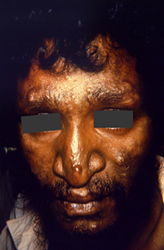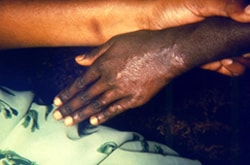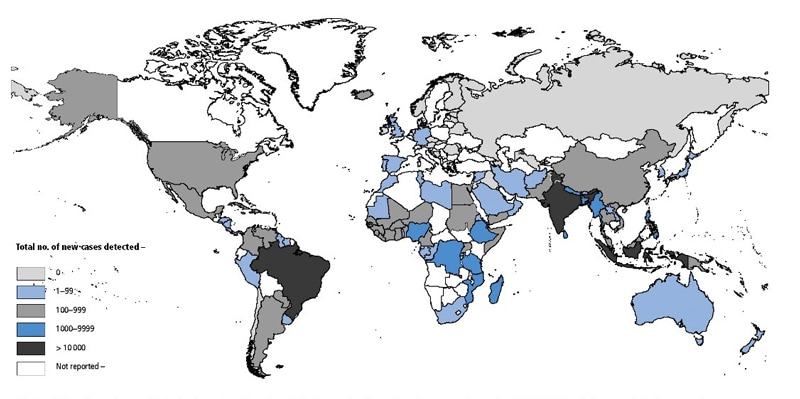Archive for the ‘Leprosy’ Category
WHO: India harbors 60 percent of the world’s leprosy cases, with more than 100,000 new diagnoses each year.
Thursday, May 16th, 2019


Hansen’s disease is a chronic infectious disease caused by Mycobacterium leprae and usually affects the skin and peripheral nerves, but can have a wide range of possible clinical manifestations.
Patients can be classified into three groups, each with slightly different signs and symptoms:
- Paucibacillary (PB), or tuberculoid, Hansen’s disease is characterized by one or a few hypopigmented or hyperpigmented skin macules that exhibit loss of sensation (anesthesia) due to infection of the peripheral nerves supplying the region. The body’s immune response may also result in swelling of the peripheral nerves; these enlarged nerves may be palpated under the skin, and may or may not be tender to the touch. The nerves most often found to have swelling are:
- Great auricular nerve
- Ulnar nerve above the elbow and dorsal cutaneous branches at the wrist
- Median nerve at the wrist (in the carpal tunnel)
- Radial nerve (superficial at wrist)
- Common peroneal nerve (also femoral cutaneous and lateral popliteal nerves where they wind around the neck of the fibula)
- Posterior tibial nerve, posterior to the medial malleolus
- Sural nerve
- Multibacillary (MB), or lepromatous, Hansen’s disease is characterized by generalized or diffuse involvement of the skin, a thickening of the peripheral nerves under microscopic examination, and has the potential to involve other organs, the eyes, nose, testes, and bone. The nodular form of this condition is the most advanced form of the disease. Ulcerated nodules contain large numbers of M. leprae acid-fast bacilli packed in macrophages that appear as large foamy cells. MB form of Hansen’s disease is associated with:
- multiple, symmetrically-distributed skin lesions that might not exhibit loss of sensation
- nodules
- plaques
- thickened dermis
- frequent involvement of the nasal mucosa resulting in nasal congestion and epistaxis
- Borderline, or dimorphous, Hansen’s disease is the most common form. When compared to tuberculoid or lepromatous forms, it is of intermediate severity. The skin lesions seem to be of the tuberculoid type, but are more numerous, and may be found anywhere on the body. Peripheral nerves are affected as well, with ensuing weakness and anesthesia.
Mumbai: 362 new leprosy cases were reported between April and December 2018 while 326 cases were found between April 2017 and March 2018.
Sunday, January 20th, 2019“…..In 2005, the Indian government declared the elimination of leprosy from the country because the number of cases had come down to less than one per 1,000 people. However, in the intervening years, new cases have been detected regularly and the Union health ministry’s deadline to eliminate the disease has been on a continuous shift.….”
WHO Key facts
- Leprosy is a chronic disease caused by a bacillus, Mycobacterium leprae.
- M. leprae multiplies slowly and the incubation period of the disease, on average, is 5 years. In some cases, symptoms may occur within 1 year but can also take as long as 20 years to occur.
- The disease mainly affects the skin, the peripheral nerves, mucosa of the upper respiratory tract, and also the eyes.
- Leprosy is curable with multidrug therapy (MDT).
- Leprosy is transmitted via droplets, from the nose and mouth, during close and frequent contacts with untreated cases.
- Untreated, leprosy can cause progressive and permanent damage to the skin, nerves, limbs, and eyes.
- There were 216 108 new leprosy cases registered globally in 2016, according to official figures from 145 countries from the 6 WHO Regions.
- Based on 173 358 cases at the end of 2016, prevalence rate corresponds to 0.29/10,000.
World Leprosy Day: Sunday, January 28, 2018 (the number of newly diagnosed leprosy patients has remained above 200,000 per year for the last decade)
Sunday, January 28th, 2018Zero Leprosy : Document
 CDC: The face of this male patient exhibited some of the pathologic characteristic associated with a case of nodular lepromatous, or multibacillary (MB), Hansen’s disease. Of note is the presence of cutaneous nodules upon the forehead, nose, cheeks, lips, and chin. The eyebrows are diminished as well.
CDC: The face of this male patient exhibited some of the pathologic characteristic associated with a case of nodular lepromatous, or multibacillary (MB), Hansen’s disease. Of note is the presence of cutaneous nodules upon the forehead, nose, cheeks, lips, and chin. The eyebrows are diminished as well.

Geographical Distribution of New Cases of Hansen’s Disease Reported to WHO in 2015
Despite the declaration that Myanmar has achieved its leprosy elimination target, about 2600 to 3000 new patients are recorded every year
Tuesday, November 21st, 2017Leprosy in the US
Sunday, November 27th, 2016“…In 2015, 178 new cases of leprosy were reported, according to the Health Resources and Services Administration. Seventy-two percent, or 129, of those cases came out of Texas, New York, Florida, Hawaii, California, Arkansas and Louisiana.
Twenty-one cases were reported in Texas in 2015 and 17 have been reported so far this year. An estimated 180 people in the state are currently undergoing treatment for the disease.
There were 211,903 cases of leprosy around the world as of 2010. The disease is rare due to the immunity that 95 percent of the population has against it. In the 1980s, the World Health Organization began its Leprosy Elimination Project. Since then, 14 million cases of the disease have been cured. ….”

